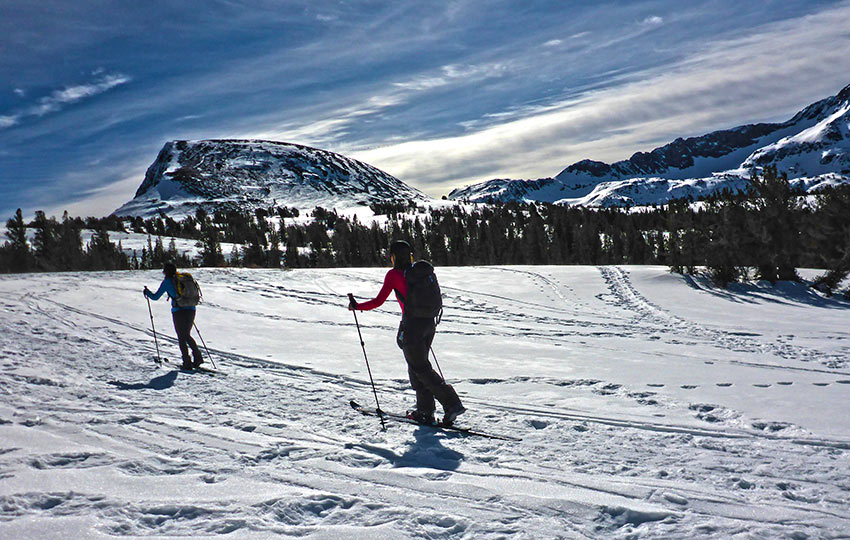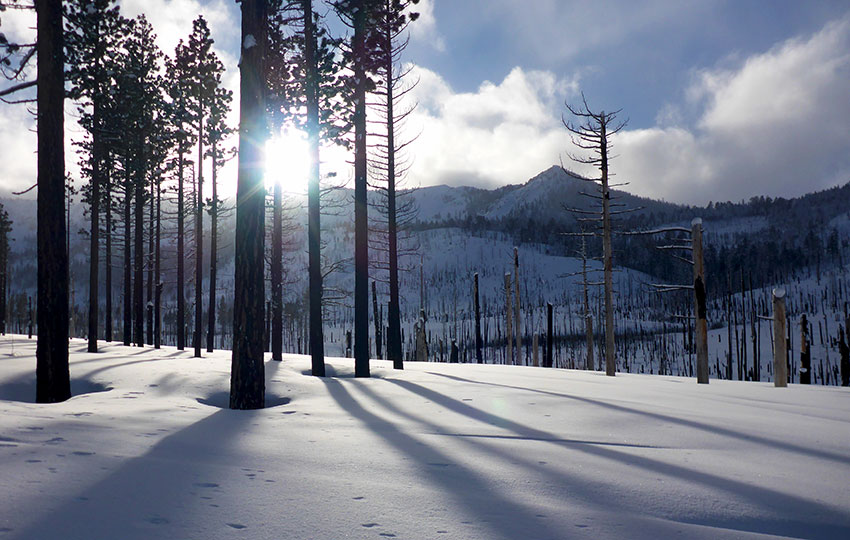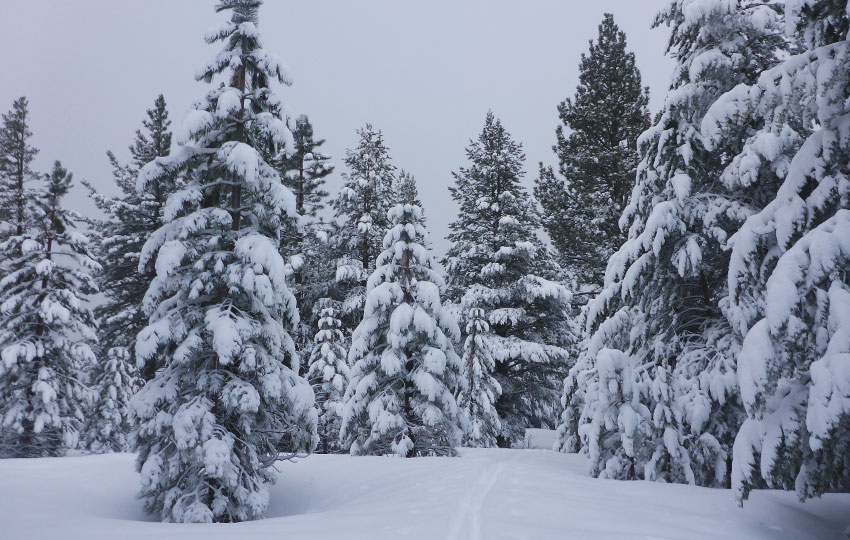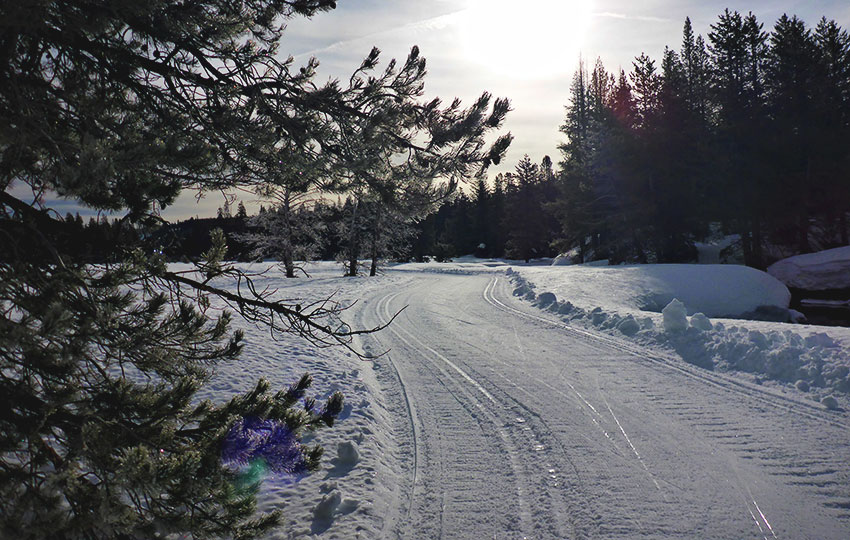
Recreational cross-country skiers rejoiced many years ago thanks to the introduction of “waxless” cross-country skis. No more sticky kick wax to deal with, particularly of the klister variety! And, no more trial and error to achieve the ideal grip for diagonal striding!
These waxless cross-country skis featured a fish scale-looking pattern in the grip zone/wax pocket of their bases. So, the scale pattern replaced the need to apply grip wax. Fantastic! Less ski preparation means more time for cross-country skiing 🙂
As an all-around classic ski, waxless cross-country skis are ideal for hobbyists, recreationalists, and citizen racers because they function well in nearly all conditions.
Support Tahoe Trail Guide with a financial contribution via PayPal (single contribution) or Patreon (reoccurring contributions). Your support of Tahoe Trail Guide is very much appreciated!

I agree that their performance doesn’t compare to a “waxable” classic cross-country ski. For those of you who don’t know, waxable skis are the types of classic cross-country skis that require grip wax for specific snow conditions. And, these are the skis that the waxless variety replaced. But, I find that that’s OK.
Not surprisingly, most of the cross-country skiers that I know don’t actually race or need high performance oriented equipment. That said, being able to put on your skis and hit the trails doesn’t tell the whole story of waxless cross-country skis.

Without question, the use of the term “waxless” in the marketing of scale-patterned xc skis worked terrifically. However, in this context waxless only refers to the use of kick wax.
You still need to routinely apply glide wax to the ski’s tips and tails. These are the areas on the base of the ski not covered with a scale or textured pattern.
Unfortunately, many people never got that memo. So, they’ve been cross-country skiing on skis that have dry, oxidized, and dirt-laden bases for years. And, they’re probably wondering why their skis don’t quite glide like they used to.
I can’t emphasize enough … you need to apply glide wax routinely to the tips and tails of your waxless cross-country skis.
Three Reasons to Apply Glide Wax to Your Waxless Cross-Country Skis
ENJOYMENT: Cross-country skis that don’t glide are no fun. Period.
There are a million fine details to learn about cross-country ski technique. However, there are technically only three phases to classic cross-country skiing (push-off, weight transfer, and glide).
By not routinely applying glide wax to your skis you eliminate that third phase of cross-country skiing. And, by the way, gliding is the best part of xc skiing!
You’re also forced to compromise your cross-country skiing technique. This is because you have to accommodate skis that don’t glide, for which they are designed.
So, if you’re skis constantly stick to the snow because you haven’t waxed them, you may as well just put them back in the shed and throw on some snowshoes.

MAINTENANCE: glide wax helps to preserve the bases of cross-country skis by keeping them “moisturized,” free of dirt, and lubricated.
As a “moisturizer,” ski wax prevents oxidation of the ski base fibers. An oxidized base has an ashen-looking color to it.
With the layer of ski wax, the bases will generally remain free of dirt. Skis will always accumulate dirt in some form. But, at least it becomes more attached to the wax rather than the actual fibers of the ski base.
Ski wax also acts as a “lubricant.” It provides a very thin barrier between the ski bases and debris on the snow. In this capacity the wax can minimize the amount of scratches to the base.
SAFETY: a cross-country ski that does not glide is no fun. A cross-country ski that does not glide is also not safe.
Free movement is a critical factor in being safe in the backcountry. But you can become trapped, isolated, or stranded miles from civilization for many reasons. However, neglecting to wax your skis shouldn’t be one of those reasons because this results in snow sticking and clumping to their bases. Then, you become completely exhausted because you’re working way too hard (because the skis don’t glide!).
In that case, well, maybe you deserve to be coyote food.
Skis with appropriate glide wax applied to their bases require much less effort to run. Additionally, they glide better. And, lastly, they’ll turn more easily when skiing downhill.
Not surprisingly, all of these things make for a safer and more enjoyable experience off-track and in the backcountry. Even when skiing at a groomed resort, you can still run into problems if you haven’t properly waxed your skis.
Some cross-country ski resorts feature well over 100km of trails. And, some of those trails are relatively far from the ski center or parking lot. At the end of the day ski patrol usually makes a final sweep of the trails. However, they don’t always. And, even when they do, they can never be 100% certain that everyone has gone home.
You and the patroller may have actually passed each other, like ships in the night. So, when you reach the furthest point from the ski resort and are too tired to return (because your skis won’t glide) you may wind up being, again, coyote food.
Thankfully, waxing your skis is something that you can control.
Understanding How Waxless Cross-Country Skis Glide
The traditional theory about the way in which cross-country skis glide across snow (using glide wax) is called “controlled friction.” As such, this theory posits that a cross-country ski travels over the thin layer of water created by the friction (heat) between the ski and the snow (as the ski moves across the snow).
So when you use the correct glide wax for the conditions, the layer of water assumes the form of tiny beads thanks to the hydrophobic quality of the wax. Imagine raindrops beading up on your vehicle’s fresh coat of wax. Then, the ski “rolls” over those beads.
So based on the theory of controlled friction, the application of glide wax will either produce:
- Excessive friction (wax too soft for the conditions)
- Ideal friction (wax appropriate for the conditions)
- Inadequate friction (wax too hard for the conditions)
Fortunately, glide waxes feature relatively broad temperature ranges. So it’s fairly easy to achieve good enough results. And if you’re not racing, good enough is, well, good enough!

An important feature of cross-country skis that works in conjunction with glide wax to produce good glide is the structure of the skis’ base.
This “structure” describes the pore-like surface of the base of skis (or snowboards) in the snow sports world.
So, structure serves to decrease the amount of suction a ski will experience. Suction occurs between the ski and the snow when the layer of water the ski is gliding over becomes too great and the structure can no longer effectively shed the excess water.
Suction makes the ski stop.
Visualize two nonporous surfaces stacked on top of each other with a layer of water between them. Maybe think of two pieces of glass for this example. Pulling the glass apart is difficult due to that layer of water (surface tension). However, by substituting one of those pieces of glass with a pitted surface (side directly in contact with the water) makes the job easier.
In that example, the pitted surface represents the structure found in the base of a ski.

Take that idea a step further by applying a thin layer of wax over the pitted surface. In that case, the two surfaces would most likely never adhere to each other at all.
But, if the structure is clogged with excess wax, dirt, grime, debris, and/or too much water, the ski won’t achieve glide. It’ll be difficult to separate from the snow. And, it’ll generally just create an exhausting experience for you.
Keep in mind that throughout this waxing process there are three main objectives we’re trying to achieve:
- Clean and open the base’s structure.
- Apply glide wax (appropriate for the snow conditions) to the base.
- Retain the thinnest possible layer of wax while revealing the base’s structure by scraping and brushing all excess wax.
Quick Waxing Your Waxless Cross-Country Skis
If you’re really, really eager to get going, here are two short videos taking you through the entire process.
For an in-depth look at waxing your waxless xc skis, I recommend reading and viewing my step-by-step tutorials. Just click that link above this section to navigate to the tutorial part of this series.
The following 5-minute wax job for your waxless cross-country skis will work when you’re short on time. However, I don’t consider this 5-minute wax job to be a long-term solution for waxing your cross-country skis.
Even the 10-minute operation in the video above is more thorough and longer lasting. So, if you have the time I recommend performing that 10-minute version. It’ll ensure you’ll have a more fun and safe cross-country skiing adventure.
Glide Waxing Waxless XC Skis in 10 Minutes
Glide Waxing Waxless XC Skis in 5 Minutes
I recommend picking up a copy of The Complete Guide to Cross-Country Ski Preparation #ad by Nat Brown. This book provides an in-depth discussion of preparing your skis. And, although it’s a bit cerebral for beginner skiers and people with little knowledge of skiing technique, the information is presented in an easy to understand format. So, I find it to be an invaluable resource that provides a thorough overview of cross-country ski preparation, which ultimately will help you to become a better cross-country skier. Follow the Amazon link and you should be able to find some options for buying a used copy. Highly recommended and worth having in your library.
Cross-Country Skiing Explained Articles and Videos
Please note that I wrote and produced the Cross-Country Skiing Explained series of articles and videos with the beginner and intermediate cross-country skier in mind. This is the demographic for whom I most often serve(d) while working in the outdoor recreation industry at Lake Tahoe. I basically treat these articles and videos as extensions of the conversations that I have (had) with those customers.
That said, expert skiers probably could take away something of value from these resources. Just know that I don’t address race-oriented philosophy, technique, or gear selection.
Considerations for buying cross-country ski gear (new and beginner xc skiers)
- Intention, Types of XC Skis, and Whether to Buy New or Used (Part 1)
- How Much Gear to Acquire, Evaluate Your Commitment, Value of Taking XC Ski Lessons (Part 2)
- Can One Set of Classic Cross-Country Skis Work for Groomed and Off-Track XC Skiing? (Part 3)
- Can I Use One Set of XC Ski Boots for All of My Cross-Country Skiing Needs? (Part 4)
- Overview of Off-Track and Backcountry Cross-Country Ski Gear
- Invest in Technique More than Gear
Classic Cross-Country Ski Components
- Introduction to Classic Cross-Country Skis (Part 1)
- Geometry of Classic Cross-Country Skis (Part 2)
- The Grip Zone of Classic Cross-Country Skis (Part 3)
- Types of Bindings for Classic Cross-Country Skiing (Part 4)
- Ski Boots for Classic Cross-Country Skiing (Part 5)
- Classic Cross-Country Ski Poles (Part 6)
- FAQs about Classic Cross-Country Skiing
Waxing Your “Waxless” Cross-Country Skis (for beginner and intermediate xc skiers)
- Introduction to Waxing Your Waxless XC Skis
- Step-by-Step Waxing Tutorial
- FAQs About Waxing Your Waxless XC Skis
Cross-Country Skiing Techniques, Demonstrations, and Related Concepts
- Outdoor VLOG (emphasis on the cross-country skiing experience)
- Cross-Country Skiing in Challenging Conditions
- Considerations for Winter Adventure in Lake Tahoe’s Backcountry
- Using the Side-Step and Herringbone Techniques in the Backcountry
- 10 Tips for Spring Cross-Country Skiing in the Backcountry
- 5 Reasons to Love Spring Cross-Country Skiing
- Considerations for Cross-Country Skiing During the Fall and Early Winter
- Discussing the Goal of Becoming a Better Cross-Country Skier and Embracing Backcountry and Groomed Terrain in Pursuit of that Goal
- The Cross-Country Skiing Experience: Immersing Yourself in Winter
Do you mind telling us the type of glide to put on the fish gills area. I am suffering badly in that area now that the snow is starting to melt. Do you need several different kinds of materials?
Hey David, thanks for the question.
Generally I’ll use a simple quick wax, like a Swix F4 or Toko Express wax. F4 comes in either a liquid type or paste. I carry a tin of paste with me in the backcountry for emergency purposes. Here’s a link to a short YouTube video I produced just for that question. http://youtu.be/YiPtXTCPGc4.
Let me know if you have other questions! And thanks again for the comment 🙂
Thanks so much for all this information: these are the best videos for answering questions and getting inspired to wax, explore, and get more out of x-country skiing. I really appreciate the explanations, the focus on getting outside, and how you get the level of detail just right: enough so I understand what I’m doing, but without getting overly obsessive. More than that, I’m making my kids (9 and 14) watch these videos for all the life-lessons!
Hey John,
Thanks so much for the kind words 🙂 I’m glad you’re finding value in my articles and videos. And, thanks for passing them on to your kids (haha!).
I produce my videos and articles in a down-to-earth style so that they’re relatable to most people. I’m not a huge fan of high-octane/hyper-stylized videos on YouTube (regardless of genre), nor am I fan of really stripped down online articles that leave out important details because either the author thinks the reader won’t understand the material or, worse, they’re not actually that knowledgeable about their subject.
So, again, I appreciate the feedback 🙂 And let me know if you ever have questions.
The problem I’m having is that the area that doesn’t get the glide wax, i/e the fish scale part in the middle of the ski, is the part that gets clumps of snow stuck to it if I’m skiing in a sunny place or if the temperature hits 33 degrees….I’ve always been told not to use glide wax on that portion of the ski…but if not, what can I do to avoid the clumping?
Hey Linda,
Thanks so much for the question! The scale pattern on waxless cross-country skis can definitely be problematic, as you’ve no doubt found out for yourself. Basically, because the skis are considered “waxless” (i.e. no need for grip wax) the grip zone is often neglected causing that area of the ski’s base to become dry. Once it dries out and the base material’s fibers begin to oxidize, snow will start to cling to that dry area.
The idea to not put any glide wax on the scale pattern is not technically wrong. But the scales need to be treated in some way otherwise they will continue to dry out.
The remedy is to treat those scales with a minimal amount of glide wax. I recommend applying a basic universal liquid or paste wax to the scales.
The other way I treat the scale patterns is to brush over the scales when I’m brushing out freshly applied glide wax (to the tips and tails). I’ll just make sure, after scraping off the new wax, that I brush over the scales using a bronze brush. The residual wax held in the bristles of the brush will lightly coat the scale pattern. This does require you to hot wax your skis (hot iron and temperature-specific block wax). So, although the fix is easy, it’ll take some time to get there.
Just to be clear, I don’t recommend hot waxing the scale patterns. I’m just talking about running the brush over the scales when your brushing off the new wax. Also note that you shouldn’t apply so much liquid or paste wax that it’ll affect the grip zone in a negative way (i.e. so much wax that you can’t get any grip). Just a quick and thin coat of it.
Honestly, just using some universal liquid or paste wax in that area should work just fine. And you’ll probably want to do this often.
Let me know how it works, and if if you have any other questions!
Hello Jared! It would be interesting to know how the Kuzmin scraper suits the Sierra Nevada snow. Please write back.
Hey Magnus, I just got home from working this past weekend and saw the Kuzmin scraper in my mailbox 🙂
We’ve been getting pounded with lots of snow these past couple weeks and more to come, so it might be a little while before I get the time to test out the scraper. But when I do, I’ll definitely let you know how it goes!
Instead of glide waxing, many skiers now only scrape and polish the glide zones: http://www.youtube.com/watch?v=VPoDYshn-Cc
Interesting. I’ve been leaning toward less work on the skis as well, mostly so I can go ski quicker 🙂 I can’t understand the guy in the video (due to my lack of speaking the language), but it appears he’s using a metal scraper and really cleaning out a lot of the oxidized fibers.
Yes, Henrik in the video uses a Kuzmin hard metal scraper but there are a number of manufacturers of these kind of scrapers, like Skimateria and Skigo, that also sell rillers and other structuring tools and polishing products.
Very interesting stuff. I may have to invest in one of those scrapers and give it a try. Although it may be challenging to find them here in the USA.
Yes, I recommend getting a hardened steel scraper, or base scraper, as they also often are called. I believe Skigo’s base scraper is available from retailers in North America, but you are probably able to order any of them from e.g. Skistart.com where Henrik in the video works. Here is an English language video with a demonstration of Skigo’s base scraper and polishing pink paper: http://www.youtube.com/watch?v=WKwZYvuiPUM